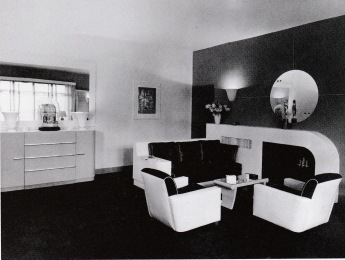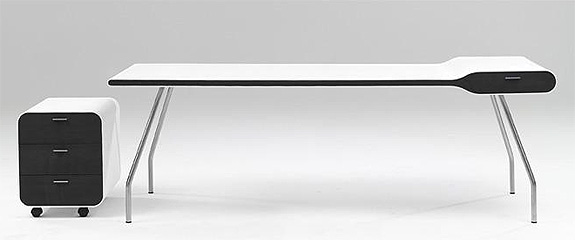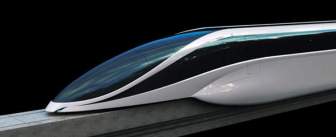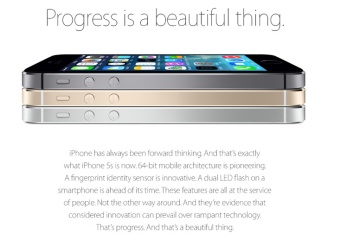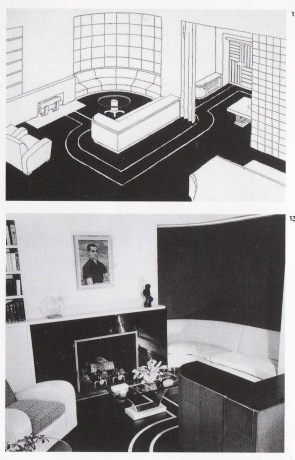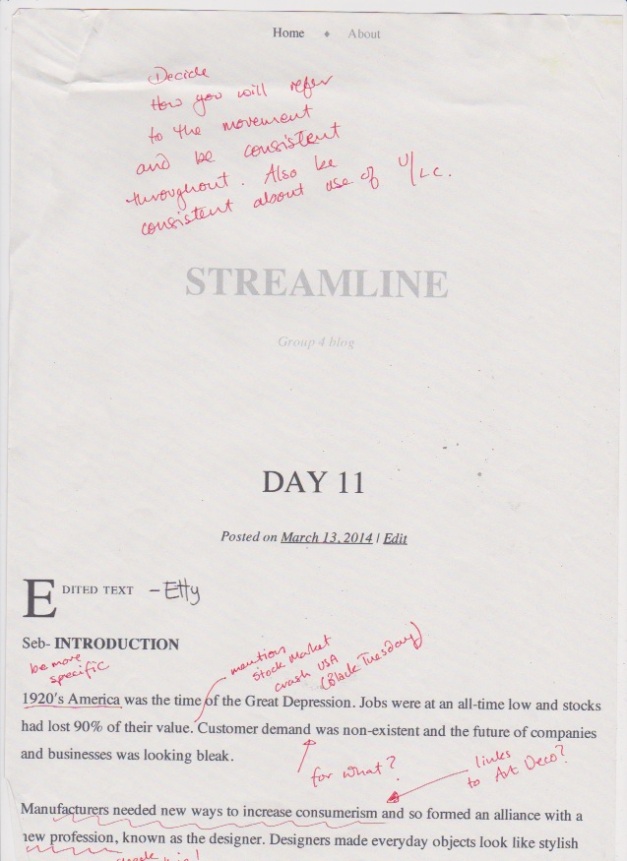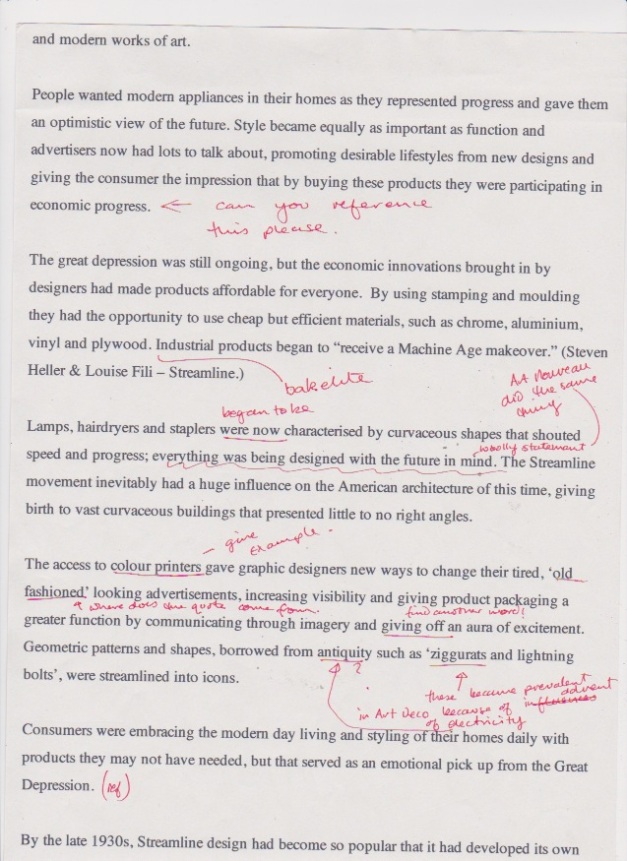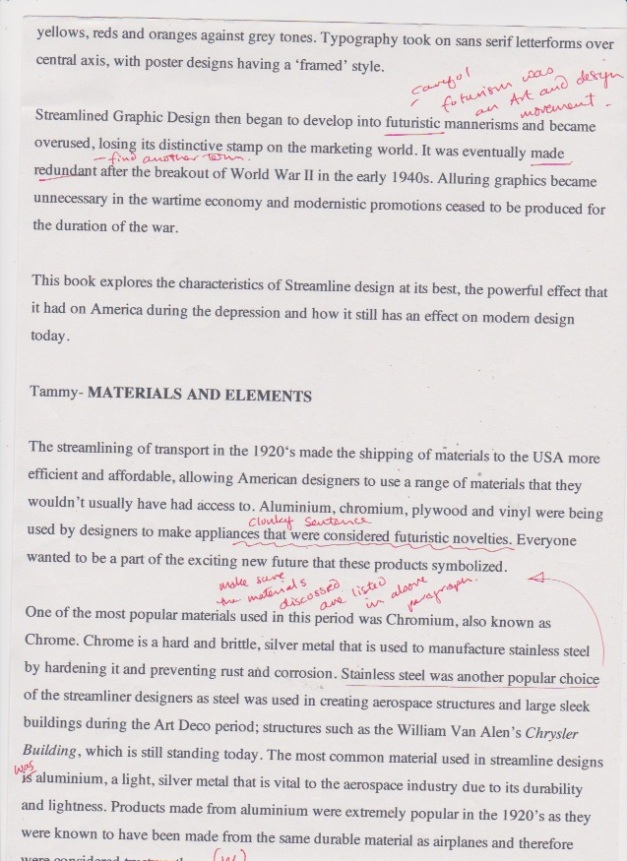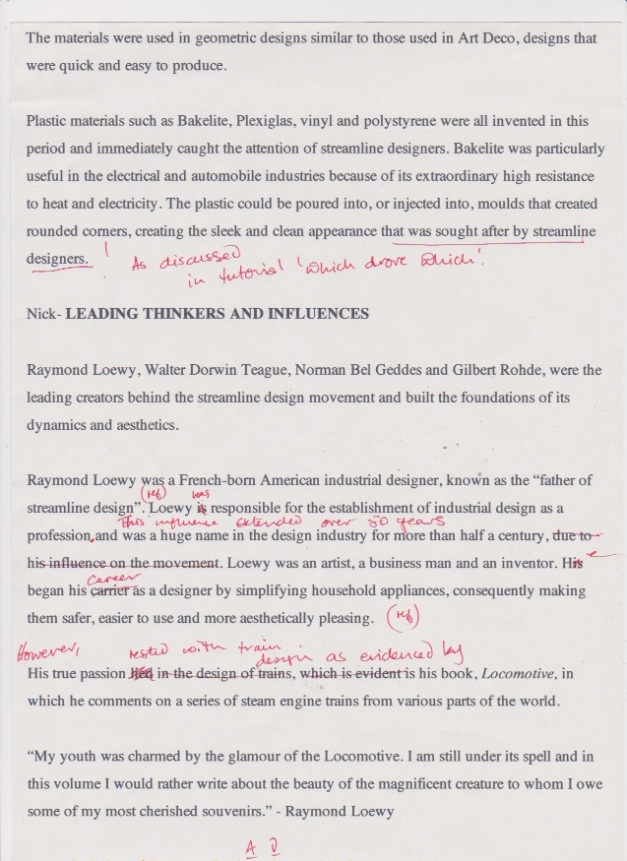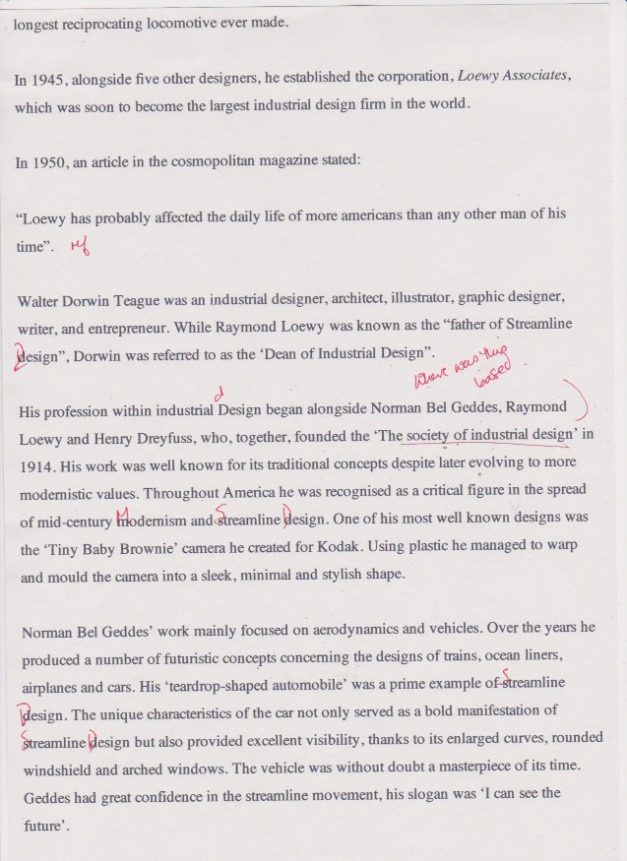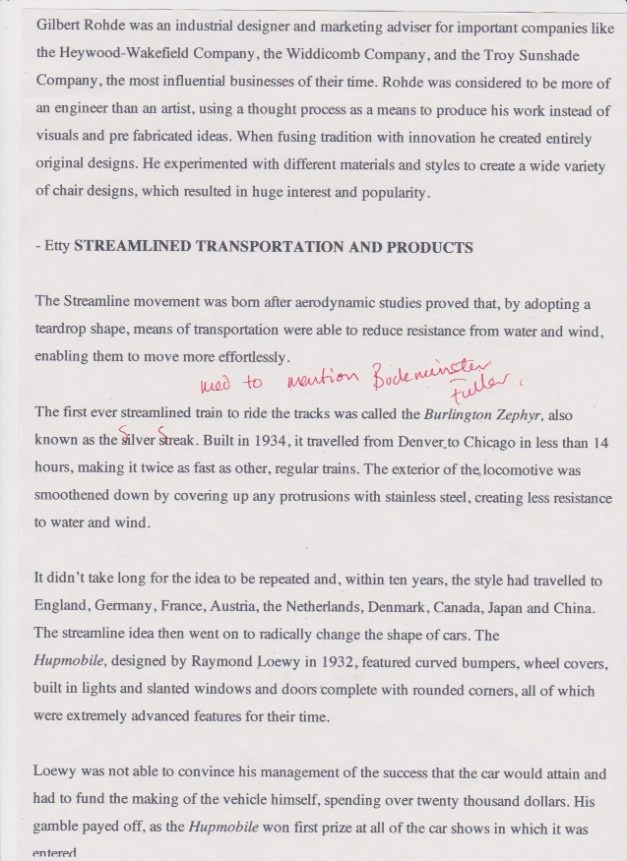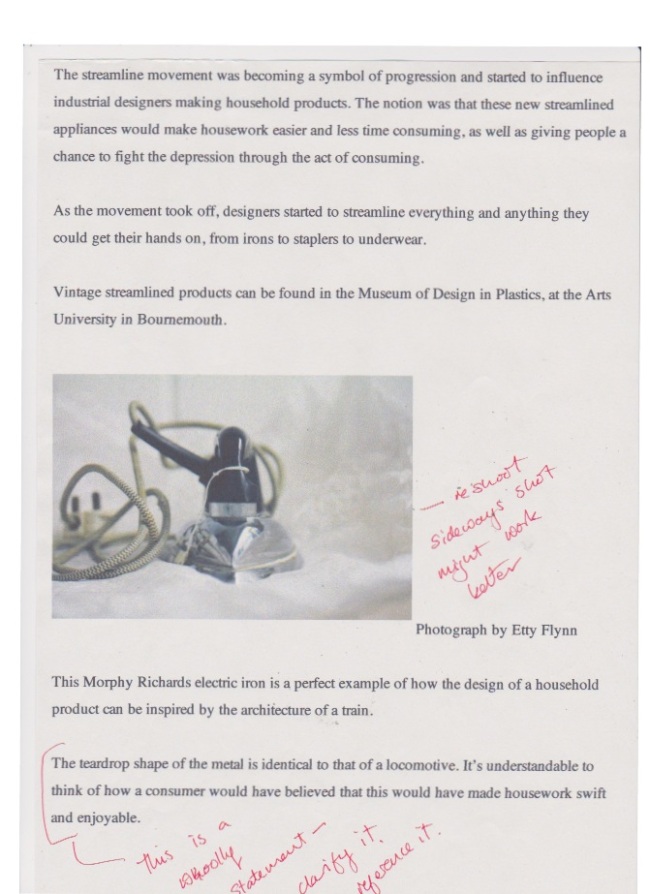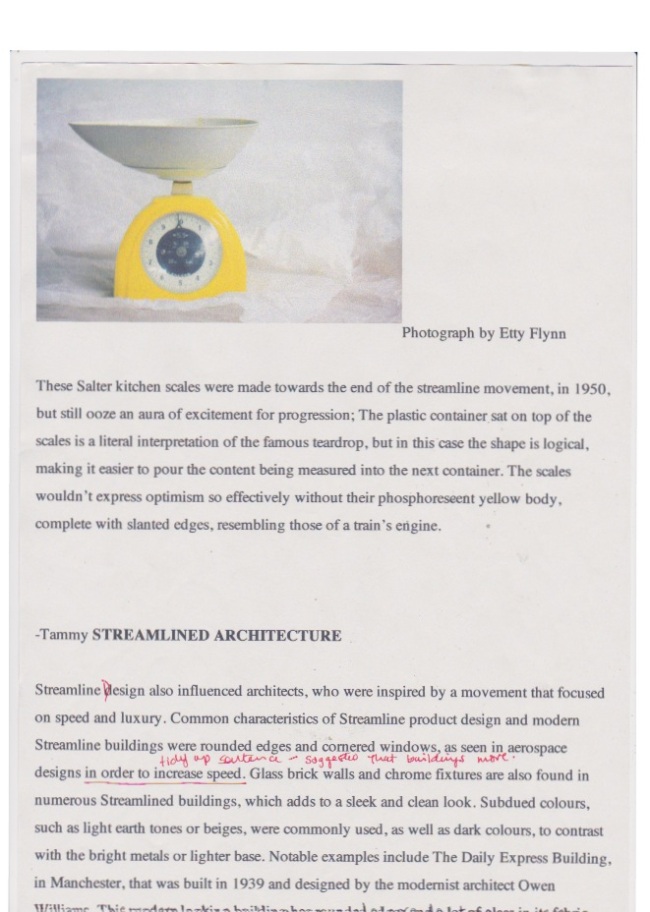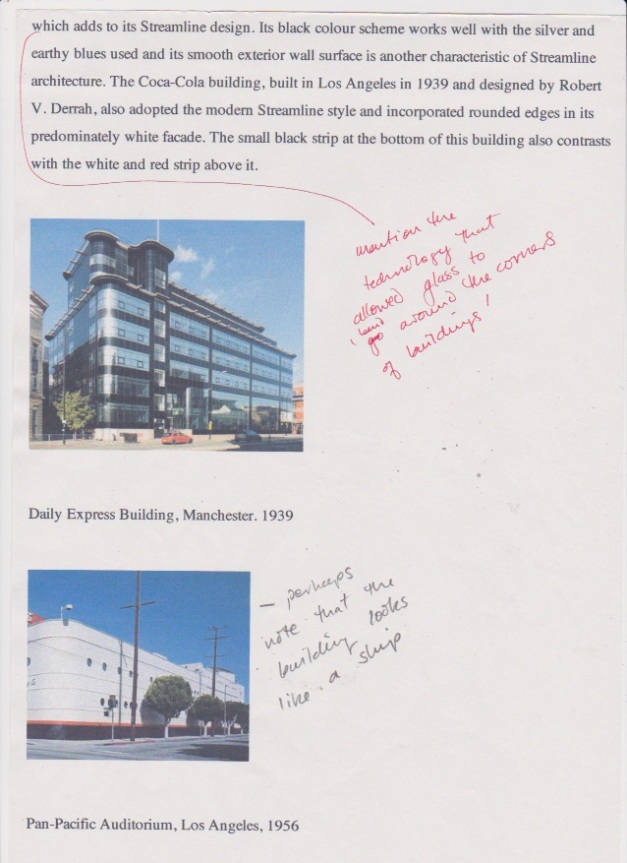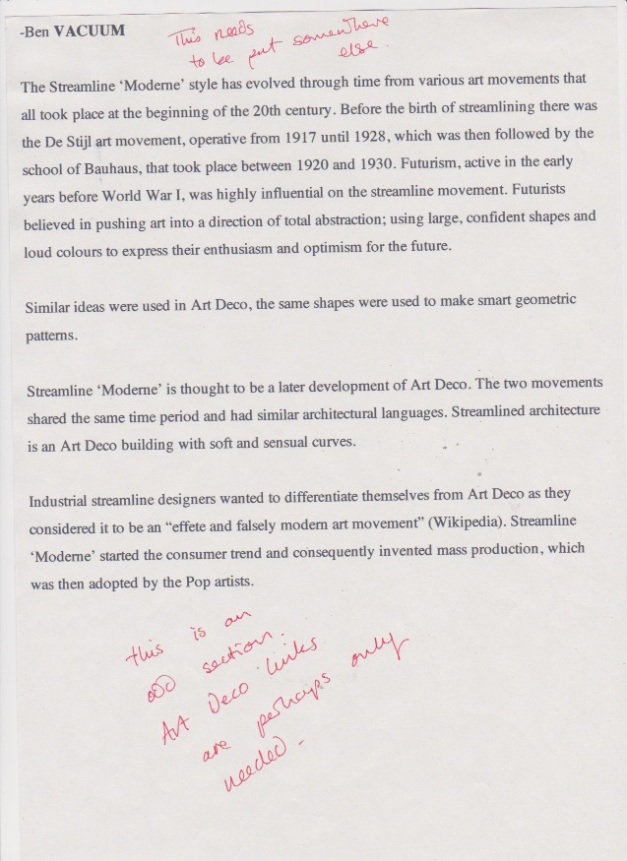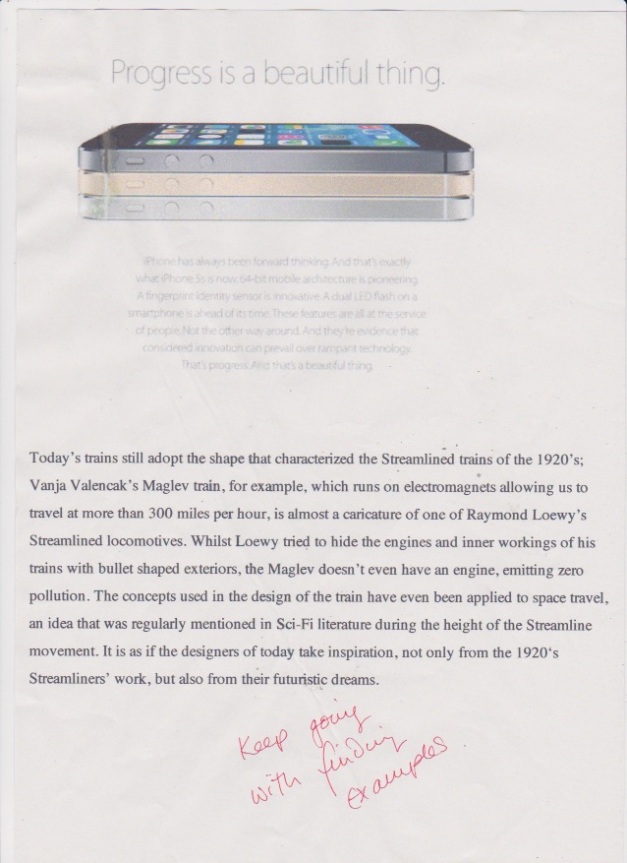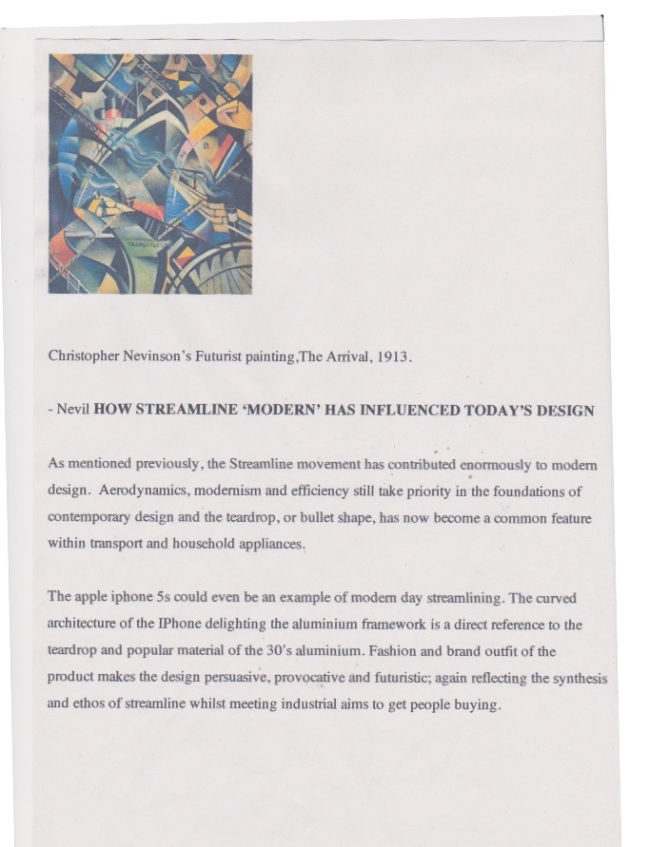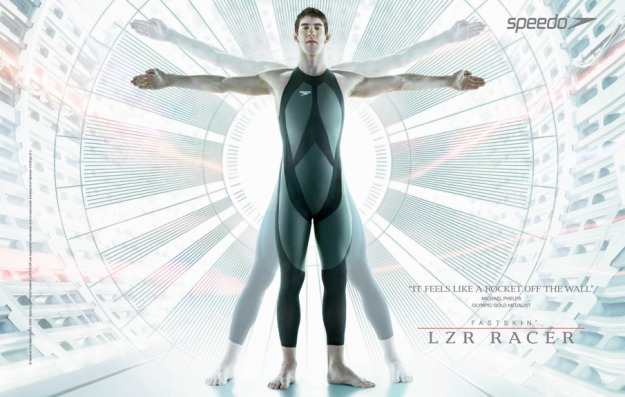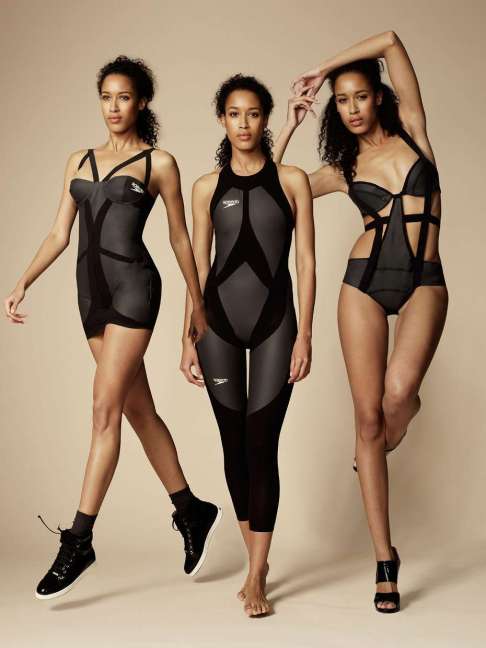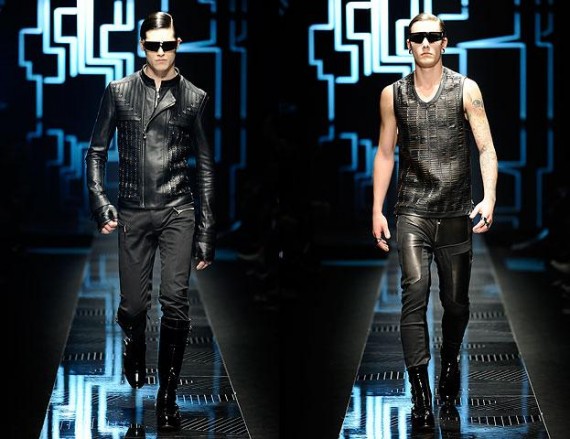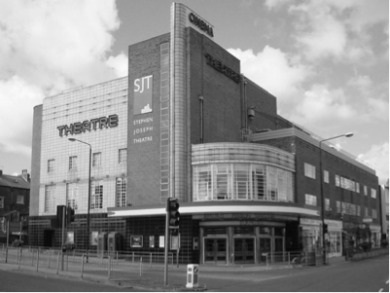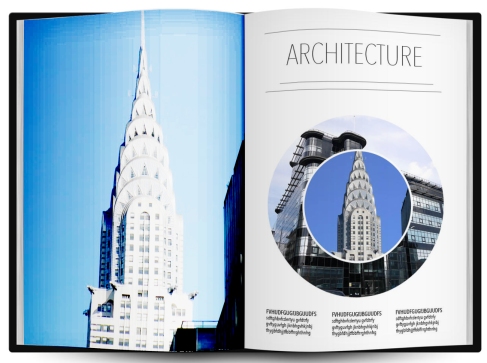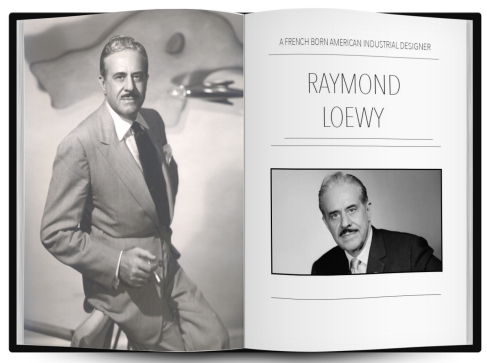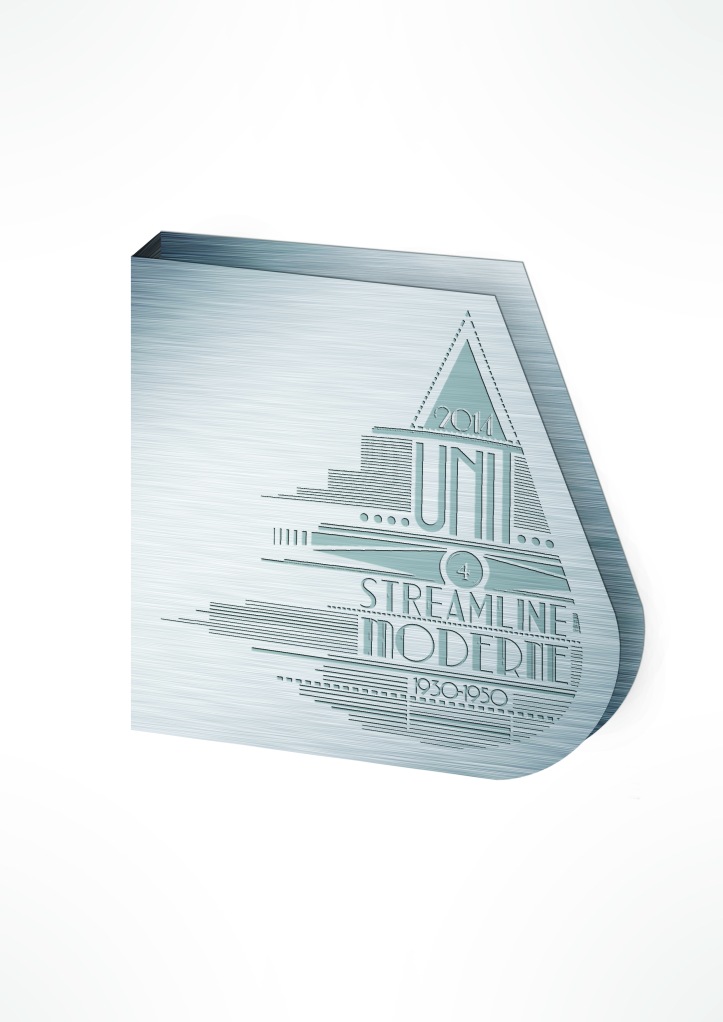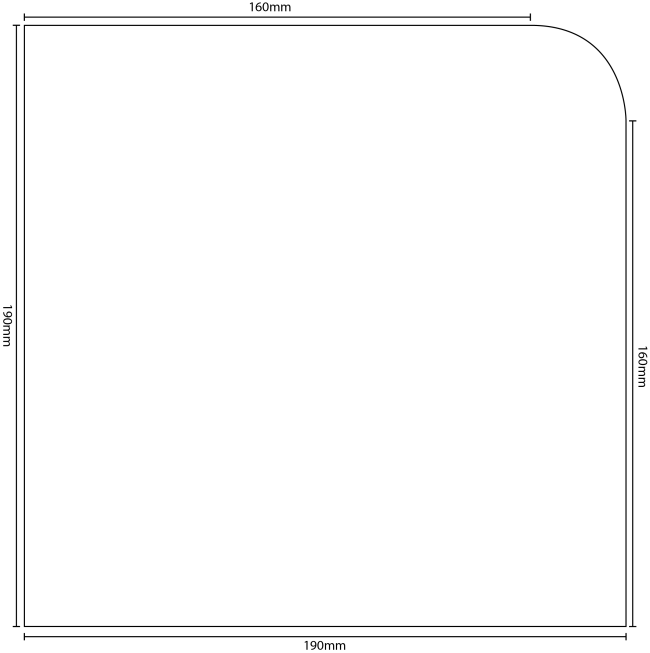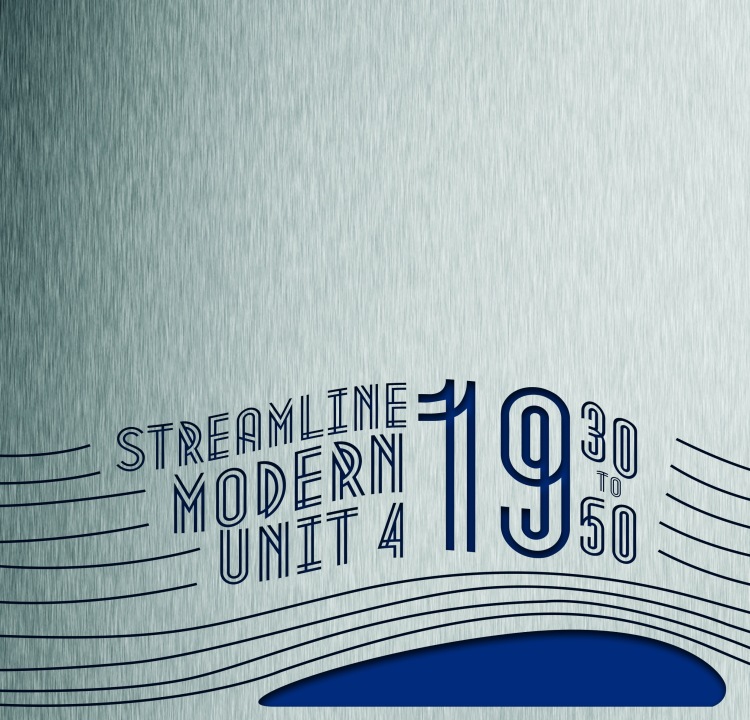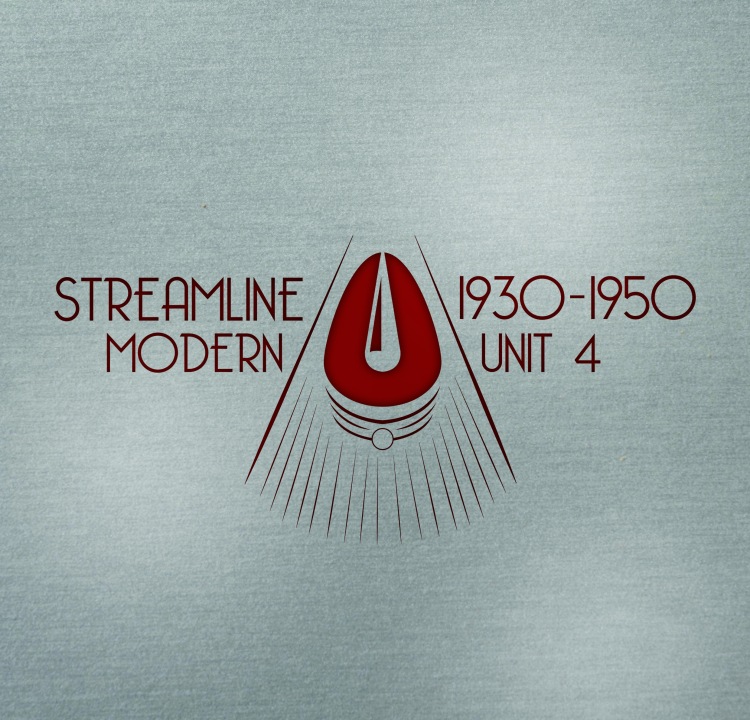Edited by Etty
First Draft, second edit:
Seb- INTRODUCTION
America was hit by the great depression during the summer of 1929. The infamous Wall Street Crash, also known as Black Tuesday, was the beginning of the most devastating economic crisis in the entire history of the United States. Stocks had lost 90% of their value and jobs were at an all-time low. Customer demand had shrunken to the bare necessities and the future of companies and businesses was looking bleak.
Manufacturers needed new ways to increase consumerism and so formed an alliance with new modern product designers that created household items that were functional and practical but, unlike the other home appliances of the 1930’s, were also stylish works of art.
People wanted modern appliances in their homes as they represented progress and gave them an optimistic view of the future. Style became equally as important as function and advertisers now had lots to talk about, promoting desirable lifestyles from new designs and giving the consumer the impression that by buying these products they were participating in economic progress.
The great depression was still ongoing, but the economic innovations brought in by designers had made products affordable for everyone. By using stamping and moulding they had the opportunity to use cheap but efficient materials, such as chrome, aluminium, stainless steel. vinyl, bakelite and plywood. Industrial products began to “receive a Machine Age makeover.” (Steven Heller & Louise Fili – Streamline.)
Lamps, hairdryers and staplers began to be characterised by curvaceous shapes that shouted speed and progress; everything was being designed with an optimistic vision of the future in mind. The Streamline movement had a huge influence on the American architecture of this time, giving birth to vast curvaceous buildings that presented little to no right angles.
Consumers started to embrace the modern day living and styling of their homes with products they may not have needed, but that served as an emotional pick up from the Great Depression.
This book explores the characteristics of Streamline design at its best, the powerful effect that it had on America during the depression and how it still has an effect on modern design today.
Ben- VACUUM
The Art Deco movement came to light soon after the end of World War I, in a time of rapid urbanisation and industrialisation. The movement began in France and then flourished internationally reaching England and as far as America and India.
Lee Lawrie, Louis Lcart and Adolphe Cassandre were the lead thinkers of the movement and began to use distinctive bright colours, large bold geometric shapes and lavish ornamentation, avoiding any organic or floral figurations from Art Nouveau, the precedent movement. Art Deco was extravagant and flamboyant and gave off an aura of glamour and luxury.
Although the Streamline movement rebelled against the feminine, natural methodology of Art Nouveau, the two movements still showed similarities; they are both driven by the invention of new technology and they were both incredibly contagious styles, making there way into Graphic design, film, photography, architecture and transport design. The main difference between the two movements was that Streamliners wanted to strip back the exaggerated ornamentation of Art Deco; they felt that the ornamentation was purely aesthetic and had no purpose. American Industrial designers saw art deco as an “effete and falsely modern art movement”.
The difference between Art Deco and Streamline Moderne can be shown with examples of clocks designed from both movements; On the left, the Art Deco designer has used angular shapes to create a brightly coloured static geometric pattern. The clock on the right is dominated by the horizontal lines used commonly in Streamlined Design to express speed. In this case the design contradicts the ethos of Streamlined design that says that ornamentation should have a function as clocks have no need for aerodynamic features.
————-PUT IMAGES OF CLOCKS HERE—————-
Tammy- MATERIALS AND ELEMENTS
The streamlining of transport in the 1930‘s made the shipping of materials to the USA more efficient and affordable, allowing American designers to use a range of materials that they wouldn’t usually have had access to. Aluminium, stainless steel, chromium, plywood and vinyl were used to make everyday objects, novelties. Everyone wanted to be a part of the exciting new future that these products symbolized.
One of the most popular materials used in this period was Chromium, also known as Chrome. Chrome is a hard and brittle, silver metal that is used to manufacture stainless steel by hardening it and preventing rust and corrosion. Stainless steel was another popular choice of the streamliner designers as steel was used in creating aerospace structures and large sleek buildings during the Art Deco period. The most common material used in streamline designs is aluminium, a light, silver metal that is vital to the aerospace industry due to its durability and lightness. Products made from aluminium were extremely popular in the 1920’s as they were known to have been made from the same durable material as airplanes and therefore were considered trustworthy.
The materials were used in geometric designs similar to those used in Art Deco, designs that were quick and easy to produce.
Plastic materials such as Bakelite, Plexiglas, vinyl and polystyrene were all invented in this period and immediately caught the attention of streamline designers. Bakelite was particularly useful in the electrical and automobile industries because of its extraordinary high resistance to heat and electricity. The plastic could be poured into, or injected into, moulds that created rounded corners, creating the sleek and clean appearance that was sought after by streamline designers.
Nick- LEADING THINKERS AND INFLUENCES
Raymond Loewy, Walter Dorwin Teague, Norman Bel Geddes and Gilbert Rohde, were the leading creators behind the streamline design movement and built the foundations of its dynamics and aesthetics.
Raymond Loewy was a French-born American industrial designer, known as the father of streamline design. Loewy was responsible for the establishment of industrial design as a profession and his influence extended over 50 years. Loewy was an artist, a business man and an inventor. He began his career as a designer by simplifying household appliances, consequently making them safer, easier to use and more aesthetically pleasing.
However, his true passion rested with train design as evidenced by his book, Locomotive, in which he comments on a series of steam engine trains from various parts of the world.
“My youth was charmed by the glamour of the Locomotive. I am still under its spell and in this volume I would rather write about the beauty of the magnificent creature to whom I owe some of my most cherished souvenirs.” – Raymond Loewy
Loewy’s design of the streamlined, Art Deco styled, S1 locomotive train, at 42.74m was the longest reciprocating locomotive ever made.
In 1945, alongside five other designers, he established the corporation, Loewy Associates, which was soon to become the largest industrial design firm in the world.
In 1950, an article in the cosmopolitan magazine stated:
“Loewy has probably affected the daily life of more americans than any other man of his time”.
Walter Dorwin Teague was an industrial designer, architect, illustrator, graphic designer, writer, and entrepreneur. While Raymond Loewy was known as the “father of Streamline design”, Dorwin was referred to as the ‘Dean of Industrial Design”.
His profession within industrial design began alongside Norman Bel Geddes, Raymond Loewy and Henry Dreyfuss, who, together, founded the ‘The society of industrial design’ in 1914. His work was well known for its traditional concepts despite later evolving to more modernistic values. Throughout America he was recognised as a critical figure in the spread of mid-century Modernism and Streamline Design. One of his most well known designs was the ‘Tiny Baby Brownie’ camera he created for Kodak. Using plastic he managed to warp and mould the camera into a sleek, minimal and stylish shape.
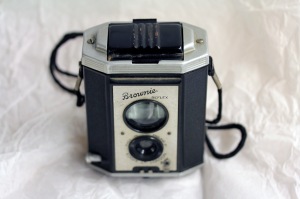
Image by Etty Flynn
Norman Bel Geddes’ work mainly focused on aerodynamics and vehicles. Over the years he produced a number of futuristic concepts concerning the designs of trains, ocean liners, airplanes and cars. His ‘teardrop-shaped automobile’ was a prime example of Streamline Design. The unique characteristics of the car not only served as a bold manifestation of Streamline Design but also provided excellent visibility, thanks to its enlarged curves, rounded windshield and arched windows. The vehicle was without doubt a masterpiece of its time. Geddes had great confidence in the Streamline movement, his slogan was ‘I can see the future’.
Gilbert Rohde was an industrial designer and marketing adviser for important companies like the Heywood-Wakefield Company, the Widdicomb Company, and the Troy Sunshade Company, the most influential businesses of their time. Rohde was considered to be more of an engineer than an artist, using a thought process as a means to produce his work instead of visuals and pre fabricated ideas. When fusing tradition with innovation he created entirely original designs. He experimented with different materials and styles to create a wide variety of chair designs, which resulted in huge interest and popularity.
– Etty, Nick and Seb STREAMLINED TRANSPORTATION AND PRODUCTS
The Streamline movement was born after aerodynamic studies proved that, by adopting a teardrop shape, means of transportation were able to reduce resistance from water and wind, enabling them to move more effortlessly.
Streamline Design has been vital in the development of aeroplanes, which are Streamlined to reduce drag, the aerodynamic force that opposes an aircraft’s motion through the air, to minimise noise
emissions and to increase their stability.
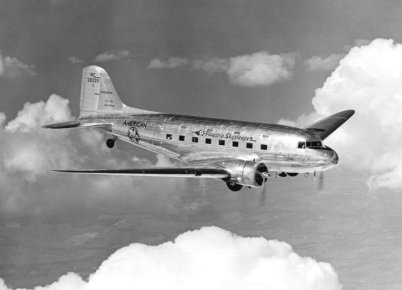
The First major Aeroplane was named the Douglas DST which took its first flight in 1935. Built in Southern California by the Douglas Aircraft Company, the plane was built for military purposes and flew Allied soldiers and supplies into combat. Its range, power and speed revolutionised air transport in the 1930s and 1940s. It was eventually sold to American Air Lines in Chicago and was approved for national flights, transporting people across America day and night.

The first ever streamlined train to ride the tracks was called the Burlington Zephyr, also known as the Silver Streak. Built in 1934, it travelled from Denver to Chicago in less than 14 hours, making it twice as fast as other, regular trains. The exterior of the locomotive was smoothened down by covering up any protrusions with stainless steel, creating less resistance to water and wind.
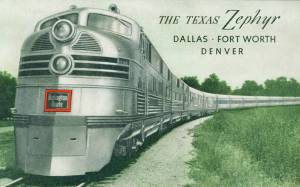
It didn’t take long for the idea to be repeated and, within ten years, the style had travelled to England, Germany, France, Austria, the Netherlands, Denmark, Canada, Japan and China. The streamline idea then went on to radically change the shape of cars. The Hupmobile, designed by Raymond Loewy in 1932, featured curved bumpers, wheel covers, built in lights and slanted windows and doors complete with rounded corners, all of which were extremely advanced features for their time.
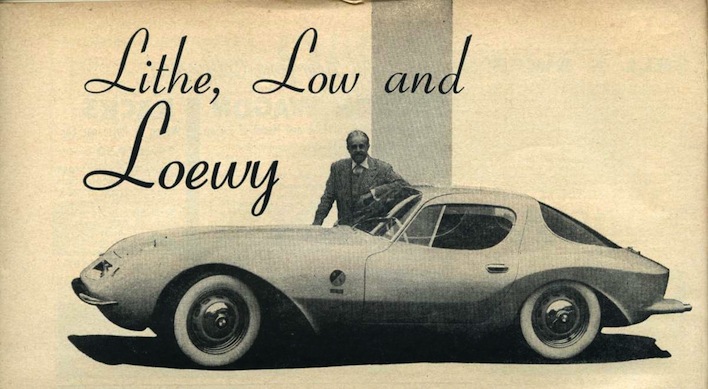
Loewy was not able to convince his management of the success that the car would attain and had to fund the making of the vehicle himself, spending over twenty thousand dollars. His gamble payed off, as the Hupmobile won first prize at all of the car shows in which it was entered-
Norman Bel Geddes’ automobile designs focused more on the aim of transporting as many people as possible, the model below was named Car no.8, a design that would have seated up to 8 people.
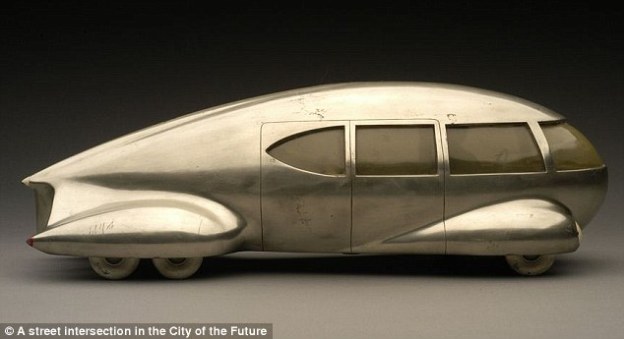
Fig. 2 Car no.8. (1933)
The model, created in 1933, featured six wheels, large windows, no tail fin and a flattened underside.
Ironically, there were issues with the aerodynamics of the vehicle concerning the flow pattern around the back and underside which would cause a drag effect, slowing it down, reducing it’s potential speed.

Fig. 3 Flow diagram – airplane to car no.8.
Bel Geddes later incorporated key features from airplane designs to his Streamlined car, allowing better airflow and aerodynamics. A tail fin was added, which would slice through the air, cutting friction and two more front wheels were built into the front of the car to level out the weight. The car was wrapped in chrome, to make it look even more similar to an aeroplane.
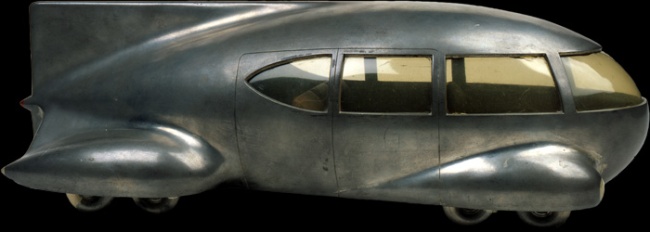
Fig. 4 1934 patent model.
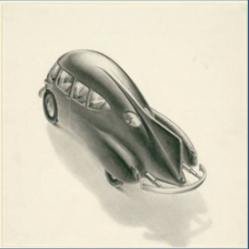
Fig 5 1934 model sketch.
Although the models were never realised, they inspired later streamlined designs; the ‘fishtail’ bottom started to appear on various cars in the mid 1940′s.
The streamline movement was becoming a symbol of progression and started to influence industrial designers making household products. The notion was that these new streamlined appliances would make housework easier and less time consuming, as well as giving people a chance to fight the depression through the act of consuming.
As the movement took off, designers started to streamline everything and anything they could get their hands on, from irons to staplers to underwear.
Vintage streamlined products can be found in the Museum of Design in Plastics, at the Arts University in Bournemouth.

Photograph by Etty Flynn
This Morphy Richards electric iron is a perfect example of how the design of a household product can be inspired by the architecture of a train.
The teardrop shape of the metal is identical to that of a locomotive. It’s easy to imagine how the consumer would have been seduced by the idea that the teardrop shape would have made their housework swift and more time effective.
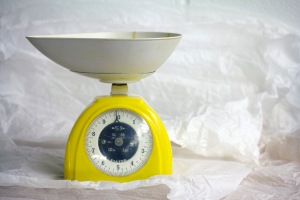
Photograph by Etty Flynn
These Salter kitchen scales were made towards the end of the streamline movement, in 1950, but still ooze an aura of excitement for progression; The plastic container sat on top of the scales is a literal interpretation of the famous teardrop, but in this case the shape is logical, making it easier to pour the content being measured into the next container. The scales wouldn’t express optimism so effectively without their phosphorescent yellow body, complete with slanted edges, resembling those of a train’s engine.
-Ryan and Seb STREAMLINED GRAPHIC DESIGN
By the late 1930s, Streamline design had become so popular that it had developed its own modernistic style in Graphic Design.
The access to colour printers gave graphic designers new ways to change their tired, old fashioned looking advertisements, increasing visibility and giving product packaging a greater function by radiating an aura of excitement. Ziggurats and lightning bolts, borrowed from the Art Deco movement, were streamlined into icons and colour palettes were simple yet eye catching, using yellows, reds and oranges against grey tones. Posters were being characterised by symmetrical and curvaceous shapes accompanied by a contrasting mixture of flourished scripts and bold, condensed typefaces.
This particular style of Graphic Design was used in posters promoting streamlined trains or in advertisements for aluminium, brass and magnesium suppliers.
Minimalistic horizontal lines were used to express speed whilst trains were depicted in huge disproportion to their surroundings, emphasising the growing demand for these particular materials.
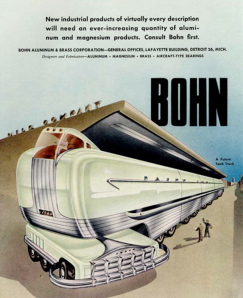
Poster by Arthur Radebaugh

Huxley™ Vertical
The Huxley Vertical font was designed by the American typographer, Walter Huxley, for the American Type Founders. The font has no hard angles but smooth rounded tips.
The long straight lines resemble those of the body of an aircraft of a train.
Streamlined Graphic Design eventually faded out after the breakout of World War II in the early 1940s. Alluring graphics became unnecessary in the wartime economy and modernistic promotions ceased to be produced for the duration of the war.
-Tammy and Ben STREAMLINED ARCHITECTURE
Streamline Design’s influence on the architecture of the 1930‘s was inevitable and architects soon began to design buildings with rounded edges and cornered windows that gradually started to resemble streamlined ships. Streamlined buildings wore subdued, light, earthy tones, beiges and bright metals, which contrasted with the Art Decoesque features that were usually painted dark shades of blue or grey. Notable examples include The Daily Express Building in Manchester, built in 1939 and designed by the modernist architect Owen Williams. Williams used rounded edges and large amounts of curved glass to streamline his designs. The black, silver and azure are used to smoothen out the exterior and as a whole, although static, the building gives off an aura of movement and speed.
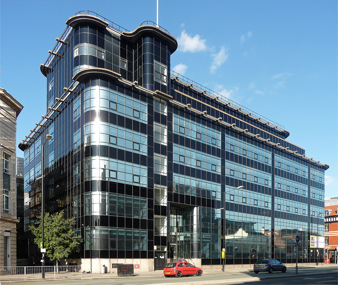
Daily Express Building, Manchester. 1939
The Coca-Cola building, designed by Robert V. Derrah in Los Angeles, 1939, is the most ship-like building to have been designed in this period. The coca-cola bottling plant is complete with portholes, a catwalk and a bridge connecting it to five existing industrial buildings that surrounded it at the time it was built. The painted on black and red strips at the bottom of the building resemble those of the hull of a ship, making the building look like it has sunken into the pavement, as if the pavement were the sea.
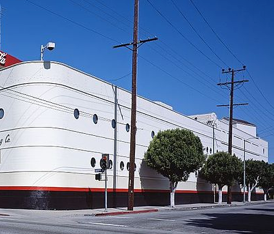
Pan-Pacific Auditorium, Los Angeles, 1956
The Odeon Cinema in Sutton Coldfield, Birmingham, was one of 250 nationwide.
The streamlined cinema was designed by Harry Weedon and Cecil Clavering and commissioned by Oscar Deutsh in 1924 . The cinema was built between 1935-36 and presents all of the streamlined characteristics including a nautical theme with rounded walls, rounded glass and small windows.
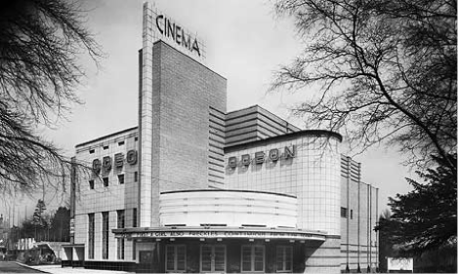
(Figure 1 Odeon Cinema Sutton Coldfield)
The design of the Odeon Cinema became a template for Streamline Architects including those in England.
– Nevil and Tammy HOW STREAMLINE ‘MODERN’ HAS INFLUENCED TODAY’S DESIGN
As mentioned previously, the Streamline movement has contributed enormously to modern design. Aerodynamics, modernism and efficiency still take priority in the foundations of contemporary design and the teardrop, or bullet shape, has now become a common feature within transport and household appliances.

The Apple iPhone 5S could be an example of modern day Streamlining. The curved edges and use of aluminium in its construction are classic characteristics of the Streamline movement, especially in its later stages when static objects were being given the same aerodynamic characteristics as those designed as means of transport. The design is persuasive, provocative and futuristic; again reflecting the synthesis and ethos of Streamline design while meeting industrial aims to increase consumerism.

The motor yacht ‘Auspicious’ was created and built by the luxurious Italian company, Mondo Marine, in 2009. The yacht was previously named ‘Streamline II’ due to it’s design being heavily inspired by the Streamline movement.
At 50 metres wide, the 19 million dollar yacht features zero speed stabilisers to keep the yacht from rocking uncomfortably, a built in swimming pool, a cinema and balconies that can be streamlined at any point by simply folding them away.
The teardrop shape and silver and grey colour scheme are clear references to the streamline movement.
Today’s trains still adopt the shape that characterized the Streamlined trains of the 1920’s; Vanja Valencak’s Maglev train, for example, which runs on electromagnets allowing us to travel at more than 300 miles per hour, is almost a caricature of one of Raymond Loewy’s Streamlined locomotives. Whilst Loewy tried to hide the engines and inner workings of his trains with bullet shaped exteriors, the Maglev doesn’t even have an engine, emitting zero pollution. The concepts used in the design of the train have even been applied to space travel, an idea that was regularly mentioned in Sci-Fi literature during the height of the Streamline movement. It is as if the designers of today take inspiration, not only from the 1920‘s Streamliners’ work, but also from their futuristic dreams.

Figure 1: EOL Maglev train – Vanja Valencak
Clock Design: (Ben)
On the pages that follow is a collection of photographs that show what a clock from the Strealine ‘Moderne’ era would potentialy look like. The clocks show the shapes and style of design that were used in the creation of them. You can also see from the collection of photographs which materials the designers used. Following the collection of photographs showing clocks form the design movment, there is more photographs that show transport from the time period as this will highlight other ditincitve shapes that were used in design during the design movement.
Materials –
The materials that you are going to read about on this page are ones that were used to create products and transport from the Streamline ‘Moderne’ design movement. Each material had its own use and was used for different applications. Some materials such as Bakelite and Stainless Steel were to be used in products inside the home whereas Aluminum was used to make transport.
Bakelite is a non conductive, heat resistant plastic made up from synthetic componants in 1907. The materials wide range of properties means it was used in electrical insulators, radio and telephone casings, and other products such as children’s toys and cameras. In 1927 there was 15 new colours introduced by the Catalin Company to the world of bakelite. They also later intoroduced Marbled Bakelite which had an effect layered on top of the Bakelite plastic. The material was used for a lot of different applications during the Streamline ‘Moderne’ .
Aluminum is a silvery white, soft, ductile metal that was found in 1808 by Humphry Davy. The metal is a light weight, low density type with a high resistantance to corrosion which was beneficial as it was used on vechiels that would be placed outside. The light weight metal allowed vechiels to move quicker as they were lighter. Due to the material being lightweight and easy to mould its main purpose in the Streamline ‘Moderne’ design movement was to be used in the production of trains and airplanes as it could be moulded into aerodynamic shapes.
Staineless Steel does not corrode, rust or stain when it is hit with water. These factors mean that Stainless Steel has many applications due to it having 150 different grades it can be addapted to most environments. The reason that Stainless Steel can be used in many different enviroments is that it can be milled into coils, sheets, plates, bars, wire, and tubing. This is because it is a soft metal that can be easily transformed into a shape. The metal was used in many buildings and cars from the Streamline ‘Moderne’ era such as the Chrysler Building and Ford cars.
Vinyl is a PVC, most commaonly known as a Plastic. Depending on the way the material is created it can be both rigid or flexiable, weather or heat resistant, impact resistant, thick or thin, and any color you would like it to be. Because vinyle was really cheap, had a low-maintainance and could be altered to be rigid or floppy it originaly only had a few uses and these included using it for piping, flooring and music records. However most of its uses weren’t discovered until the later half of the 20th centuary.
Even though glass had been used for centuried before the Streamline ‘Moderne’ art movement, new techniques such moulding and stamping allowed the glass to be curved into new shapes that had never been seen before. During the time period of the design movement curved glass was used a lot in the architecture from this time period. This was because it made the building more aerodynamic as wind that flew past was deflected away with curved glass. It was also used a little in packaging, company such as Coke Cola used it in there packaging.
Techniques –
During the beggining of the 20th centuary new techniques were created which allowed the Industrial Designer of the time to interact with materials in new ways. A few of these new techniques were called stamping and moulding which were both reveloutionary in there indiviual ways. Because of the new technology, the designer was able to create a wide variety of new products.
Stamping is a technique that came about in the 1930’s, it involves either punching, embossing, bending, and coining into a piece of sheet metal. This technique is normaly a popular technique because it can be used in a variety of products across a range of industries. The technology also allows the technique to have a good finish without haveing to be coated afterwards.
Moulding is industrial process that is used in shaping liquid that will then cool or shaping pliable material. The materials are shaped useing a mould or matrix. Such materials that can be placed into these molds include plastic, glass, metal and even ceramics. Because of this techniue a lot of new home products were able to be created becuase the technology allowed the products to have rounded corners as the material cooled in the mold. This was beneficial as the material wasnt to brital that it would crack when it was touched, because before moulding was created if people were trying to create curves with materials such as plastic it would be to brital and could possibly break.
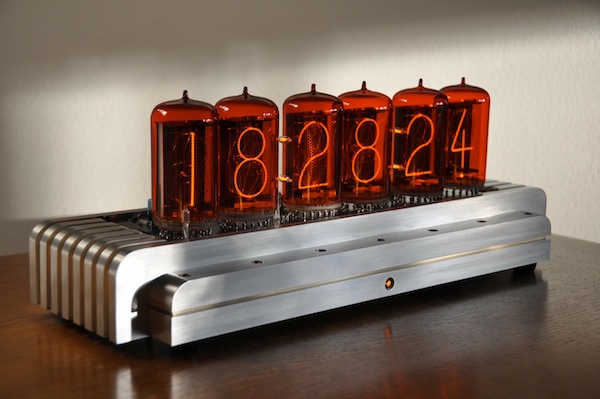

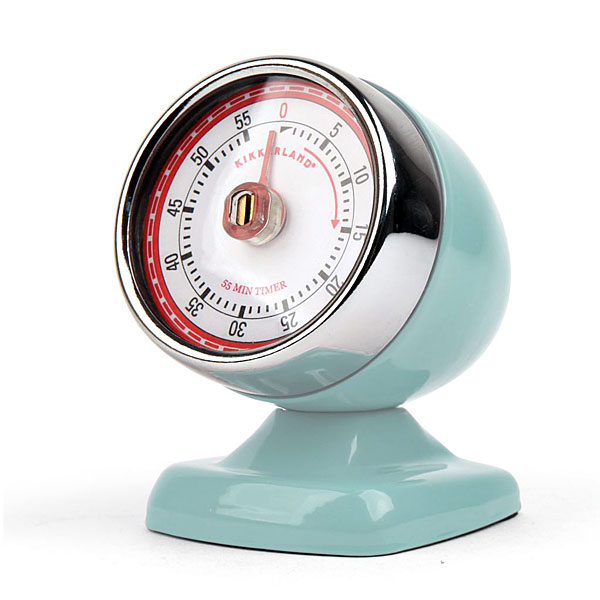


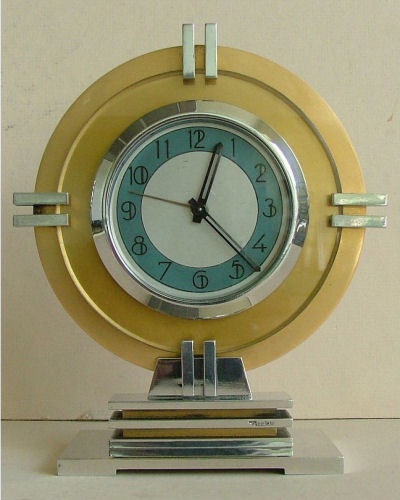

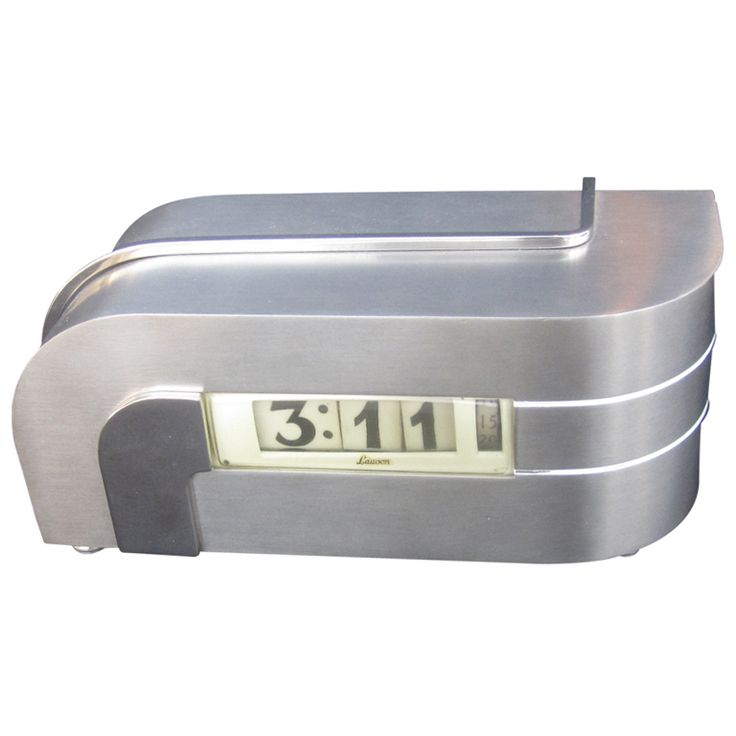

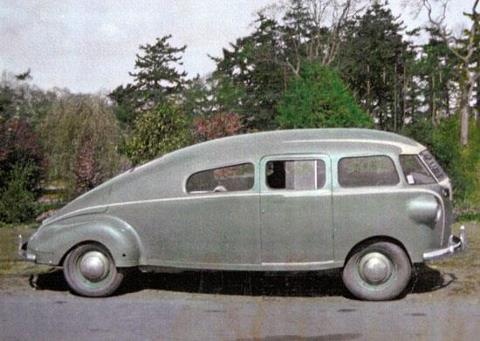
Timeline
Nick-
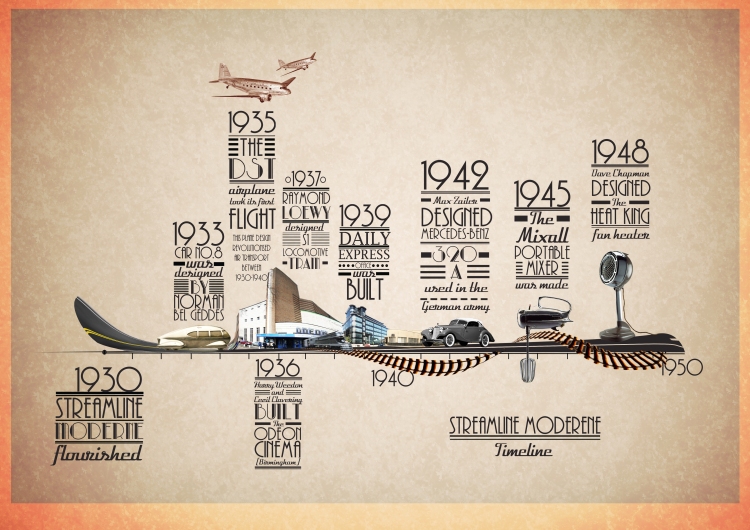
Tammy –
The motor yacht ‘Auspicious’ was created and built by a luxurious, Italian company called Mondo Marine in 2009. The company designs, constructs and carries out the engineering to its yachts at its production site at Savona, Italy. The yacht was previously named ‘Streamline II’ as it’s luxurious interior was designed by Luca Dini Design and its exterior styling was by Cor D Rover, a Dutch design studio specialised in the styling of large motor yachts. Measuring 50.80 metres wide the streamline inspired yacht is a beautiful, incredible vessel that features sleek lines with naval architecture. Many characteristics of streamline design is adopted into this approximately $19 million yacht as it is of one sleek, seamless body. The rear of the yacht features rounded edges that highlight its strong element. Some of its special features include a built in pool, zero speed stabilizers which keep the yacht from rocking uncomfortably, a cinema which can be converted into a 6th cabin and fold down balconies. The use of including elements that can be converted into something else adds to the unique style of streamlining and exaggerates its high quality and modernistic feel is it made to be desirable and look expensive, which was inspired by streamlining. The silver, white and black colour scheme also resembles numerous streamline designs that were made of stainless steel, chrome and aluminium. The shape of the yacht is also slightly teardrop shaped with also resembles streamline design as it has similar characteristics of being fast and sleek as its shape exaggerates a feel of movement, speed and futuristic qualities.
Fig ?. Auspicious Motor Yacht – Italy. (Mondo Marine, 2009).
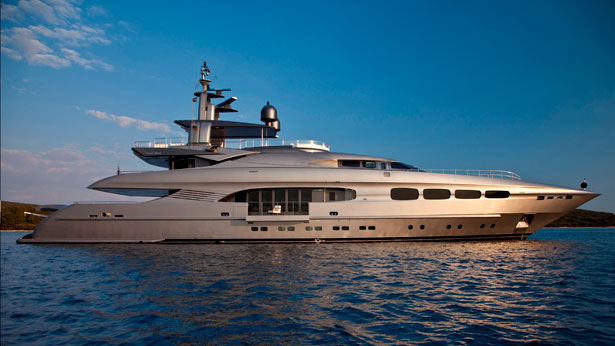
Bibliography
Boat International. (n.d). Auspicious. [online] Available from: http://www.boatinternational.com/yacht-sales/30608/auspicious-for-sale
Yacht Charter Fleet. (n.d). Auspicious yacht for charter. [online] Available from: http://www.yachtcharterfleet.com/luxury-charter-yacht-24383/auspicious.htm
Charter World. (n.d). Motor yacht Auspicious (ex streamline, Project Streamline 2) – A Mondo Marine Superyacht. [online] Available from:
http://www.charterworld.com/index.html?sub=yacht-charter&charter=motor-yacht-streamline-8740
Yacht Charter Fleet. (n.d). Auspicious yacht for charter. [online] Available from: http://www.yachtcharterfleet.com/luxury-charter-yacht-24383/auspicious.htm
Ryan –
Streamline Moderne design movement has been largely influential to the locomotive industry. Streamlining trains involved adding metal panels to the outside of the locomotive. The panels would smooth the external appearance of the locomotive which not only gave them a unique aesthetic of the period. The plating also served the purpose of reducing fuel consumption due to the decrease in air resistance. The idea behind streamlining was to increase speed, although it was never really achieved.
A good example of streamlining in locomotives is the Duchess of Hamilton, which was built in Britain in 1938 where it was then exported to the United States for a 3,000 mile tour. This steam locomotive shows the key characteristics of streamline modern such as long horizontal lines which are painted onto the streamlining plates. It also shows the tear drop shape at the front of the train which breaks through the air cleanly reducing drag through its aerodynamic properties. The use of curved lines instead of harsh angles in the body work helps reduce the turbulence of the air passing over them which reduces the drag factor.
The Duchess of Hamilton then returned in 1942 after its tour and visit to the 1939 New York World’s Fair. The streamlining was removed from the fitted locomotives from 1946 onwards. It had been found to be of little value at speeds below 90mph and was unpopular with running shed employees as it caused difficulty of access to maintenance staff. In 2009 they re-streamlined it so it could be displayed at the national railway museum in York.
Bibliography:
http://locomotive.wikia.com/wiki/Streamlining
http://en.wikipedia.org/wiki/File:6229_Duchess_of_Hamilton_at_the_National_Railway_Museum.jpg
http://www.heritagerailway.co.uk/news/streamlined-duchess-to-go-main-line-to-see-the-a4s
Ryan text –
Rabinowitz (2006, p.34) Stated that “an art deco style called Streamline was introduced at the 1933 Chicago world’s fair. A lot of the typography design that was inspired by this movement, was based on the same principles as their physical design; such as the use of aerodynamics, motion lines and speed.
Huxley Vertical was designed by an American typography designer Walter Huxley for the American Type Founders. This typeface was inspired by the Art deco Streamline Moderne movement because it shows some key characteristics that apply to design during the 1930’s period. The rounded tips of each letter indicate it was inspired by Streamline Moderne. The architecture and industrial design during the period incorporates rounded corners in a “tear drop” shape, as this is aerodynamically efficient shape due to the drag coefficient. This typeface also incorporates long straight lines which were also a key feature in Aerodynamic Streamline products such as aircraft and train bodies. There are also no hard angles in this typeface all the characters have smoothed corners which links to the movement.
Rabinowitz, T. (2006) Exploring Typography, Clifton Park NY, Delmar Learning.
This poster created by Arthur Radebaugh was made in 1947 to promote an aluminium, brass and magnesium supplier. The use of large industrial streamlined train indicates that there is a huge demand for metals which they supply to the manufactures. The scale of the people in comparison to the train emphasizes this as it gives the viewer an approximate size reference. It uses a bold condensed typeface for the name of the company, which is a key indication that this was from the streamline moderne period. The poster communicates a futuristic.
– Nev
Here is my book design for our streamline book. http://issuu.com/nevilanthonyfernandes/docs/the_book
The fonts used in the book should be used in our individual book designs.
Metropolis 1920, Bellerose, Raavie
